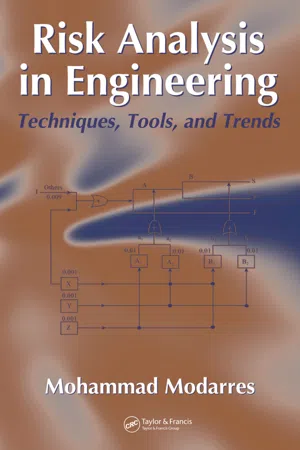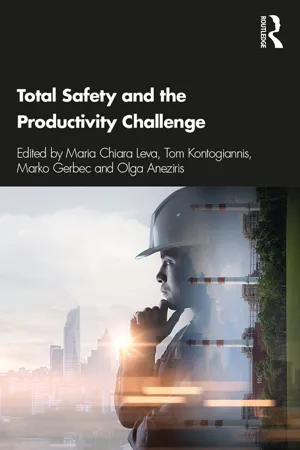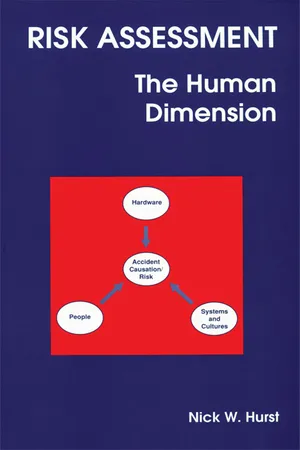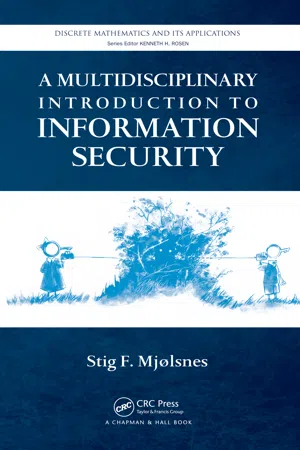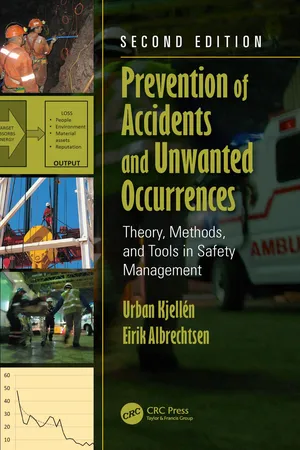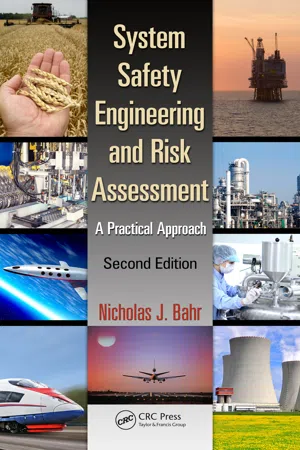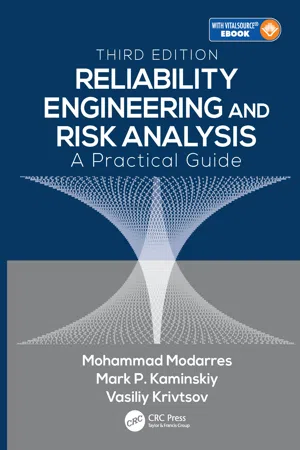Technology & Engineering
Risk Assessment
Risk assessment involves identifying, analyzing, and evaluating potential risks associated with a technology or engineering project. It aims to determine the likelihood and impact of these risks and develop strategies to mitigate or manage them effectively. By conducting risk assessments, organizations can make informed decisions to minimize potential negative outcomes and enhance project success.
Written by Perlego with AI-assistance
Related key terms
1 of 5
10 Key excerpts on "Risk Assessment"
- eBook - PDF
Risk Analysis in Engineering
Techniques, Tools, and Trends
- Mohammad Modarres(Author)
- 2016(Publication Date)
- CRC Press(Publisher)
2 Elements of Risk Assessment 2.1 TYPES OF Risk Assessment In this chapter, we discuss the main elements of engineering Risk Assessment. The focus will be on the general techniques for Risk Assessment along with simple examples of using these techniques for qualitative and quantitative Risk Assessments. Risk Assessment techniques have been used by both government and industry to estimate the safety, reliability, and effective-ness of various products, processes, and facilities. A Risk Assessment may focus on the health effects that occur when toxic chemicals and biological contaminants are released into the environment or consumed by people. This type of Risk Assessment is referred to as a health Risk Assessment. A Risk Assessment may focus on the adverse environmental, health, and economic effects that can occur when an ‘‘engineered’’ system fails, due to natural or human-initiated events followed by failure of protective or mitigative barriers, culminating in human, environmental, and economical consequences (losses). This type of Risk Assessment is usually referred to as engineering Risk Assessment. While we talk about both types of Risk Assessments, the primary focus of this book and this chapter is on engineering Risk Assessment with emphasis on safety Risk Assessment techniques. In an engineering Risk Assessment, the analyst considers both the frequency of an event, initiating a scenario of subsequent failure events and the probabilities of such failures within the engineering system. But in a health risk assess-ment, the analyst assesses consequences from situations involving chronic releases of certain amount of chemical and biological toxicants to the environment with no consideration of the frequency or probability of such releases. The ways for measuring consequences (amount of losses) are also different in health and engineering Risk Assessments. - eBook - ePub
- Maria Chiara Leva, Tom Kontogiannis, Marko Gerbec, Olga Aneziris, Maria Chiara Leva, Tom Kontogiannis, Marko Gerbec, Olga Aneziris(Authors)
- 2019(Publication Date)
- Routledge(Publisher)
2 Understanding hazards and risksPassage contains an image
From the basics to new frontiers Micaela Demichela and Gabriele Baldissone3 Process Risk AssessmentIntroduction
Process Risk Assessment is nowadays a mature discipline that is based on consolidated techniques and tools for each phase of its cycle. The definition of “risk” and the methodologies falling under the acronym PRA – Probabilistic Risk Assessment – have arisen from the nuclear domain and laid the foundations of technological risk evaluation (Rasmussen 1975).Technological risk refers to the undesired consequence of a particular hazardous activity in relation to its likelihood of occurrence . This clearly means that the risk (R ) can be seen as the product of two parameters: F , the expected probability that a hazardous event could occur within a given time interval; and M , the severity of the consequences ensued (Magnitude).From the Rasmussen’s Report the logical link between the two is set to:R = F · MThis simple definition of technological risk allows safety analysts to assess risks and make comparisons between the foreseeable risks associated to a given process or plant or to examine whether risks fall within particular tolerability limits.Since process plants are usually complex socio-technical systems, the Risk Assessment process requires a procedure to control this complexity and to support risk-based decision making within the Total Safety Management framework (see Chapter 1 ).The Risk Assessment procedure
As discussed in Chapter 1 , standard ISO 31000:2009 defined a framework for Risk Assessment that is coherent with most process Risk Assessments from early days, although with some variations. According to Figure 3.1 - eBook - PDF
Socio-Technical Networks
Science and Engineering Design
- Fei Hu, Ali Mostashari, Jiang Xie, Fei Hu, Ali Mostashari, Jiang Xie(Authors)
- 2010(Publication Date)
- CRC Press(Publisher)
245 References ........................................................................................................ 246 230 ◾ Jonathan Scott Corley and Fei Hu © 2011 by Taylor & Francis Group, LLC improved by identifying the points of failure through application of various condi-tions of threat. Risk analysis is a widely studied topic. In order to assess risk, it must first be defined. Risk is generally defined as the combination of the occurrence probability of damage and its gravity. Likewise, Risk Assessment is defined as the series of logical steps used to systematically examine the risks associated with an operational system [15]. But the difficulty in determining or defining which steps should be taken to analyze the system increases as the complexity of the system increases. This is the case for applying risk analysis to sociotechnical systems, where this system is defined as one in which influential interactions occur between humans and some organizational infrastructure. Sociotechnical systems are inherently multi-dimensional and highly complex. A means of defining the method for performing risk analysis to a given sociotechnical system is not necessarily applicable to other systems. Each application is typically unique and highly dependent on the domain of interest. Different studies addressing the difficulty of applying risk analysis to a socio-technical system are summarized in this chapter. Each describes the complexities that arise in accurately representing the system of interest, as well as, consideration of identifying all contributing factors. 9.2 Bayesian Belief Network Approach for Risk Analysis [5] It is widely accepted that the human element plays a major role in most accidents involving modern ships. The Transportation Safety Board of Canada (TSB) [2] concluded that 74% of accidents at sea are attributed to human error whereas only 1% is attributed to technical failures. The chart in Figure 9.1 displays the results of these statistics. - eBook - PDF
Risk Assessment
The Human Dimension
- N Hurst, David R Williams, Pam Marshall(Authors)
- 2007(Publication Date)
- Royal Society of Chemistry(Publisher)
This complexity is not an issue concerning the inability of some people to understand what is clear to others. The complexity arises from the difficulty of understanding interlinked ideas and thoughts where different views, knowledge and perspectives have legitimate parts to play. Many workers in the Risk Assessment field are aware of these different perspectives and complexities. Thus, many accept that a risk estimate which considers only hardware failures and ignores safety management, safety culture and human error cannot be considered complete. Because of this, links between safety cultures, human errors, safety management and Risk Assessment are important to establish, and this chapter will describe in general terms the efforts which have been made to develop tools which make these connections explicit. The Risk Assessment perspectives described in this chapter build on the perspectives of accident causation described in Chapter 1 and the theoretical ideas described in Chapter 2. To illustrate this change of emphasis from an understanding of accident causation to an assessment of risk the figures in Chapter 3 use ‘Risk Assessment’ as their central idea. Hand in hand with this change, there is a tendency for the language of The Assessment of Risk - Quantification 43 Chapter 3 to be somewhat more technical than in the previous or subsequent chapters. 3.1 ENGINEERING APPROACHES TO Risk Assessment 3.1.1 Hazard Identification and Risk Assessment As explained in the Glossary, the terminology associated with the terms ‘hazard’ and ‘risk’ are a particular source of difficulty. To reiterate, a hazard is defined here as an object or a situation with the potential to cause harm. Thus a hazard in the workplace might be a chemical or a machine - anything which can hurt people if certain circumstances prevail, e.g. a chemical is spilt and inhaled, or contact is made between a person and a moving machine, is a hazard. - Stig F. Mjolsnes(Author)
- 2011(Publication Date)
- Chapman and Hall/CRC(Publisher)
• Alternatively, there are no vulnerabilities that can be exploited and the con-trols in place successfully prevent the hacker from penetrating the system. No adverse effects are experienced. 13.2.4 Risk Analysis, Risk Evaluation, and Risk Assessment The terms risk analysis, risk evaluation, and Risk Assessment also needs to be defined. The three terms and how they are related are visualized in Figure 13.2. All of these definitions are based on ISO/IEC 27001 [6] (which in turn is based on ISO/IEC Guide 73:2002 [3]): Risk Assessment 267 Risk analysis is systematic use of information to identify sources and to estimate the risk. In this definition, the term source is used. This could cover both threat and incident as defined above. However, in practical terms, sources should be the relevant incidents that may occur. Estimate risk will usually mean that the probability of the unwanted events and the consequences are described or estimated qualitatively or quantitatively and combined. Since threats can be present constantly (as a condition), it is not always meaningful to talk about the probability of the presence of a threat, as opposed to the probability of something happening (an event). It can be assumed that hackers exist so it does not really make sense to ask what the probability of hackers existing is, but we may ask what the probability that hackers will attack a system is. In simple terms, risk analysis is about answering three questions: • What can happen (what are the events/incidents)? • What are the causes (and the probability) of this happening (what are the hazards or threats)? • What are the consequences if this happens? The next term that we need to define is risk evaluation : Risk evaluation is the process of comparing the estimated risk against given risk criteria to determine the significance of the risk.- eBook - PDF
Prevention of Accidents and Unwanted Occurrences
Theory, Methods, and Tools in Safety Management, Second Edition
- Urban Kjellen, Eirik Albrechtsen(Authors)
- 2017(Publication Date)
- CRC Press(Publisher)
Planning is another important part of this initial activity; become familiar with the object, establish risk acceptance criteria, establish the analysis team, make a time sched- ule, collect background information, and so on. 2. Identification of hazards and unwanted occurrences where people, the environment, or material assets may come into contact with a hazard. 3. Risk analysis (i.e. establishing a risk picture by determining the frequencies and the consequences of the unwanted incidents). Some standards and guidelines for Risk Assessment integrate hazard identification and risk analysis into the same activity. 4. Risk evaluation (i.e. comparing the results of the risk analysis with risk acceptance criteria to determine whether the risk is acceptable or not). 5. Risk treatment (i.e. decisions on and implementation of measures to eliminate or reduce risk where required). Risk management means the total coordinated activities that take place to direct and control an organisation with regard to risk (ISO 2009). Thus, it includes Risk Assessment and risk treatment together with com- munication of information about risk as well as systematic monitoring 341 Chapter twenty: The Risk Assessment process and review of processes. Figure 20.1 illustrates the relationship among the activities in risk management. The outcome of a Risk Assessment process is by nature a feed- forward process. Instead of information on the actual or historic perfor- mance (i.e. feedback), information on expected results of a future activity is distributed to decision-makers as new input to modify and improve the activity. Occupational accidents occur in what Rasmussen characterises as loosely coupled work systems with a relatively high accident frequency but low magnitude of loss (Rasmussen 1997). The Risk Assessment process itself utilises feedback mechanisms in applying historical data in combi- nation with judgements of future conditions. - eBook - PDF
- John Barnfield, Gary Daniels, Hywel Davies, Andrew Foolkes, Chris George, Chris Hallam, Roger Harrison, Danny Hopkin, Martin J. Kealy, Russell Kirby, Sam Liptrott, Ben McColl, Tim Nichols, Andrew Nicholson, Benjamin O'Regan, James Perry, Matt Ryan, Martin Shipp, Brent Sutherland, Nick Troth, Paul Wa(Authors)
- 2019(Publication Date)
Risk Assessment can also be used to perform a systematic comparison of different risk control/reduction options, so that the optimal design or management solution can be selected. It is not, however, appropriate to carry out a Risk Assessment to justify a deci-sion that has already been made. Risk Assessment is input to the decision-making process, not output from that process (Gadd et al., 2003). This publication is supplied by CIBSE for the sole use of the person making the download. The content remains the copyright property of CIBSE 5-2 Fire safety engineering It may not be possible for a fire engineer alone to assess the fire risks associated with certain hazards (e.g. in deter-mining whether certain equipment is ‘critical’ if assessing fire risk to business or process continuity). In this case, it will be both necessary and appropriate to draw on the skills and experience of others in order to undertake an adequate assessment of fire risk. In the context of the built environment it is not usual for the design of premises to be based solely on the results of Risk Assessment. It is more often used either to address specific risks not foreseen by the good practice guidance or to justify variations from particular recommendations in that guidance, where their application would result in a non-optimum design. 5.2 Risk Assessment process Where the Risk Assessment input is simple and straightfor-ward, it may not be necessary to consider it as an activity separate from the normal design, review and acceptance/ approval process for the project, especially where the risk of non-approval is judged to be low. For more complex Risk Assessment, it is good practice to establish and agree how the Risk Assessment will be conducted and its acceptability criteria before embarking on any significant activity. This reduces the risk of carry-ing out work that may later prove to be wasted. - eBook - PDF
System Safety Engineering and Risk Assessment
A Practical Approach, Second Edition
- Nicholas J. Bahr(Author)
- 2018(Publication Date)
- CRC Press(Publisher)
The same damage states can be quantified in numerous ways, depending on the kinds of results you seek. A typical cost–benefit analysis can be conducted in which an accident is equated with dollars lost. Or you could look at number of people killed or injured, measurable damage to the environment, or even percent loss of productivity. PRACTICAL TIPS AND BEST PRACTICE A very good thumbnail way to remember to consider the entire system as dis-cussed in Chapters 2 and 5 is to think of these four considerations: • People —What kind of people issues or human characteristics do you need to consider, organizationally, governance, decision rights, human factors, training, awareness, etc.? • Process —What are the processes, procedures, work activities, regu-lations, and business processes in place that impact the system? • Technology —What are the technologies involved, IT, instrumenta-tion, etc.? • Infrastructure —What are the physical facilities, layout, plant loca-tion, etc., and how do they impact the system? 347 Risk Assessment In the risk evaluation, the risks are calculated, and risk profiles—used to compare the different risks—are generated. The purpose of the risk profiles is to understand better which scenarios are relatively riskier. This will be very important for the risk management. Again, any risk perception concerns identified in step 1 are applied to the risk management. This is one point many engineers do not want to face. As much as someone may dislike the politics of work, or the consequences of the product in the public’s eye, it is very important. These issues can help a product sell well, or it can drive it out of the market. Risk management is the systematic decision-making processing of deciding how to disposition the risks that have been identified in the Risk Assessment. 13.4 IDENTIFYING RISK IN A SYSTEM Chapters 5 through 9 are the best sources for tools to identity risk in the system. - eBook - PDF
Reliability Engineering and Risk Analysis
A Practical Guide, Third Edition
- Mohammad Modarres, Mark P. Kaminskiy, Vasiliy Krivtsov(Authors)
- 2016(Publication Date)
- CRC Press(Publisher)
427 8 Risk Analysis Risk analysis has three elements: Risk Assessment, risk management, and risk communication. There are many interactions and overlaps between these three main elements of risk analysis. The first element of risk analysis is assessment: the process through which the chance or frequency of a loss due to an item’s failure and the magnitude of the loss (consequence) is measured. Risk management is the process through which the potential (likelihood or frequency) magnitude and contributors to risk (loss) are evaluated, minimized, and controlled. Risk communication is the process through which information about the nature of risk (loss) and consequences, the risk-assessment approach, and the risk-management options are exchanged and discussed between the decision makers and other stakeholders. Risk analysis measures the potential and magnitude of any loss from or to a system. If there are adequate historical data on such losses, the risk analysis can be directly measured from the statistics of the actual loss. This approach is often used for cases in which data on such losses are readily avail-able. For example, ample field data are usually available in car accidents, cancer risk, or the frequency and magnitude of certain storms. When there is no event on the actual losses, the loss is modeled using risk analysis methods. In this analysis, the potential loss (i.e., the risk) is predicted. There are not many cases, especially for complex engineering systems, for which data on losses are available. Therefore, often we must model and predict the risk. Risk analysts attempt to measure the magnitude of a loss and the consequences associated with complex systems, including evaluation and firming up policies. Generally, there are three types of risk analysis: quantitative, qualitative, and a mix of the two. Each of these widely used methods has different purposes, strengths, and weaknesses. - eBook - PDF
Systems Engineering for the Digital Age
Practitioner Perspectives
- Dinesh Verma, Dinesh C. Verma(Authors)
- 2023(Publication Date)
- Wiley(Publisher)
During this process, it is useful to review the project with respect to potential categories of risk. The SEI Taxonomy of Software Development Risks Kendall et al. (2007) is a useful aid for this purpose. Summary This chapter discussed approaches to managing risk during project development and sustainment with a particular focus on agile-based projects within large enterprise systems. Risk is generally defined as the measure of the potential inability to achieve overall program objectives within defined cost, schedule, and technical constraints. What is missing from this definition are risks associated with failing to identify and capture evolving user, system, and technical requirements, which are often driven by evolving end-user or marketplace demands. Ignoring these evolving needs introduces risks, meaning you may be developing an obsolete product or one that only par- tially meets end-user needs. This chapter focused on managing three types of risks to systems engineering and development: project development risk, technical risk, and obsolescence risk. References Agile Alliance (2023). Agile 101. https://www.agilealliance.org/agile101/. Corryton, TN: The Agile Alliance. Baldwin, C.Y. and Clark, K.B. (2000). Design Rules: Volume 1. The Power of Modularity. Cambridge, MA: MIT Press. Boehm, B. (1986). A spiral model of software development and enhancement. ACM SIGSOFT Software Engineering Notes 11 (4): 14–24. DAU (2003). Risk Management Guide for DoD Acquisition, 5e. Belvoir, VA, USA: Defense Acquisition University (DAU)/U.S. Department of Defense, Fifth Edition, Version 2. Managing Risk 470 Forsberg, K. and Mooz, H. (1994). The relationship of system engineering to the project cycle. Proceedings of the 12th INTERNET World Congress on Project Management, Oslo, Norway (9–11 June 1994). Kendall, R.P., Post, D.E., Carver, J.C. et al. (2007). A Proposed Taxonomy for Software Development Risks for High-Performance Computing (HPC) Scientific/Engineering Applications.
Index pages curate the most relevant extracts from our library of academic textbooks. They’ve been created using an in-house natural language model (NLM), each adding context and meaning to key research topics.
